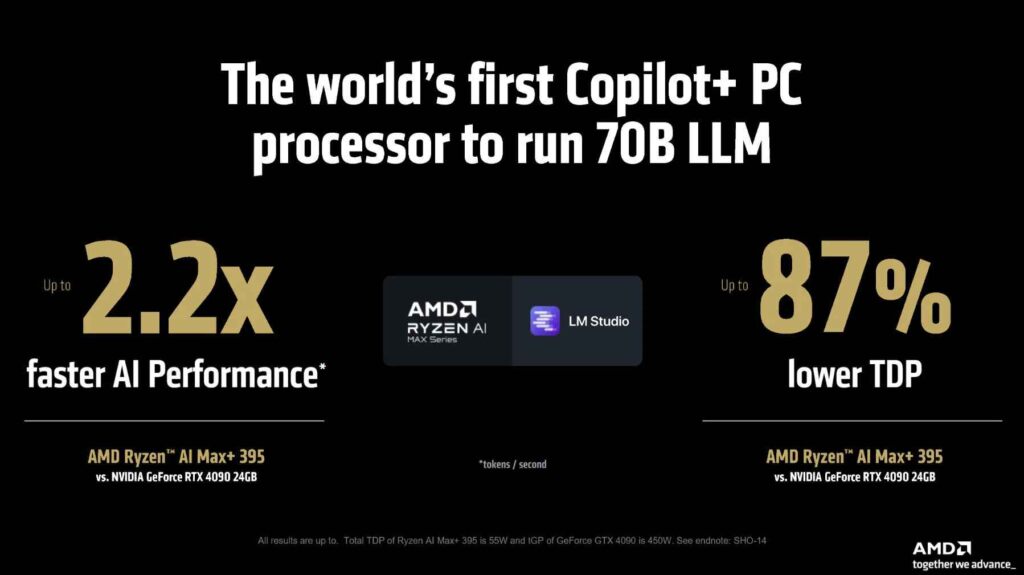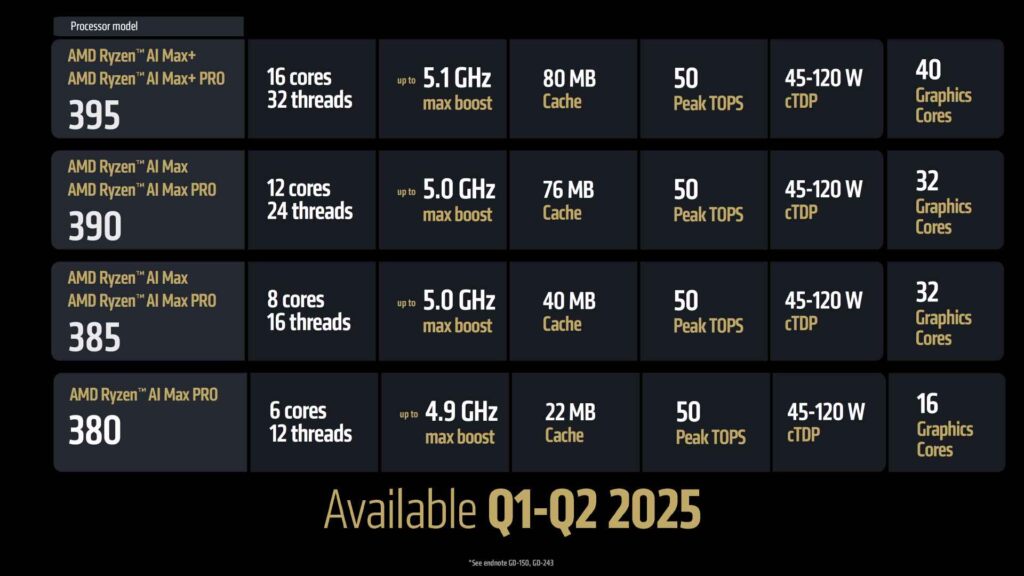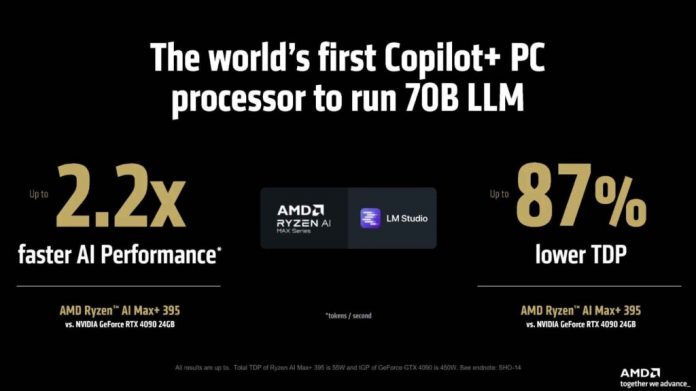AMD took center stage at CES 2025 with the launch of its Strix Halo Ryzen AI Max processors, promising an unprecedented leap in AI and graphics performance for laptops and workstations. With up to 16 Zen 5 cores, 40 RDNA 3.5 GPU cores, and an advanced unified memory system, the Strix Halo series aims to set a new standard for mobile computing.
AMD claims its flagship Ryzen AI Max+ 395 delivers 2.2 times the AI performance of Nvidia’s RTX 4090 GPU while consuming 87% less power, offering a tantalizing glimpse into the future of integrated AI hardware. The processors are set to debut in Q1 2025 in premium laptops from Asus, HP, and MSI.
Related: AMD Introduces Ryzen 9955X3D and RX 9070 XT at CES 2025
Unified Memory as A Game-Changer for AI
The standout feature of the Strix Halo processors is their unified memory architecture, which allows the CPU, GPU, and neural processing unit (NPU) to share up to 128GB of memory at 256GB/s bandwidth. This architecture reduces latency, improves data flow, and enhances performance across workloads that rely on large memory pools, such as machine learning and real-time rendering.
AMD highlighted during its CES presentation that the unified memory design significantly improves AI-centric tasks by offering scalability for large-scale AI models and complex graphics workflows.
This design is particularly beneficial for AI workloads, enabling the Strix Halo processors to handle massive datasets and perform complex computations with ease. By comparison, traditional systems often suffer from bottlenecks when transferring data between separate memory pools for CPUs and GPUs.
Performance That Challenges Industry Leaders
AMD’s Strix Halo processors are positioned as direct competitors to Intel’s Core Ultra 9 288V, Apple’s M4 Pro, and Nvidia’s RTX 4090 GPU. In extensive benchmarks shared during CES 2025, the Ryzen AI Max+ 395 demonstrated its prowess:
- AI Workloads: The processor outperformed Nvidia’s RTX 4090 by 2.2x in a 70-billion-parameter large language model (LLM) test, such as Llama 3.3.
- Gaming Performance: It offered 1.4x faster graphics rendering than Intel’s flagship Core Ultra 9 in titles like Steel Nomad.
- Creative Applications: Benchmarks in Blender Classroom and Vray showed an 84% improvement in rendering speeds over Apple’s MacBook M4 Pro.
The XDNA 2 NPU, which delivers 50 TOPS of AI performance, plays a key role in these gains. AMD’s integration of this neural processor ensures that the chips excel in both precision and speed.


Diverse Models for Varied Needs
The Strix Halo lineup includes a range of models to cater to different user profiles:
- Ryzen AI Max+ 395: Featuring 16 Zen 5 cores, 40 RDNA 3.5 GPU cores, 80MB cache, and a boost clock of 5.1GHz, this flagship model is built for high-end AI and gaming workloads.
- Ryzen AI Max 390: A mid-range option with 12 cores, 32 GPU cores, and a 5.0GHz boost clock.
- Ryzen AI Max 385: Designed for mainstream users, with 8 cores and 32 GPU cores.
- Ryzen AI Max Pro 380: An entry-level model featuring 6 cores and 16 GPU cores, ideal for professionals needing security-focused features.


The Pro variants of these chips offer additional reliability features, including extended software stability and enterprise-grade security.
AMD’s Strix Halo processors are part of a broader push to dominate AI-centric computing. Complementing the high-end series, the company also announced its Ryzen AI 300 and 200 series, which aim to make AI capabilities more accessible to everyday users. The Ryzen AI 7 350, for instance, delivers competitive performance with eight Zen 5 cores and a base TDP of 15W, targeting longer battery life and efficiency.
By addressing both premium and mainstream markets, AMD is positioning itself as a versatile player in the AI space, capable of catering to gamers, creatives, and professionals alike.
With the Strix Halo series, AMD is taking a bold step to redefine what’s possible in mobile AI and graphics performance. As laptops equipped with these processors hit the market in early 2025, they promise to set new benchmarks in efficiency, scalability, and capability. Whether it’s handling large AI models, delivering stunning visuals in games, or enabling creative professionals to push boundaries, the Strix Halo processors represent a key moment in AMD’s evolution.

